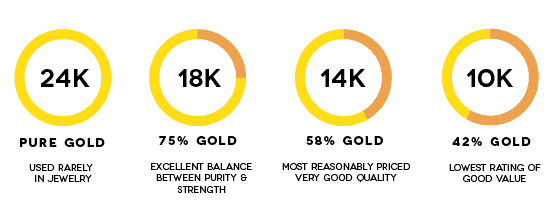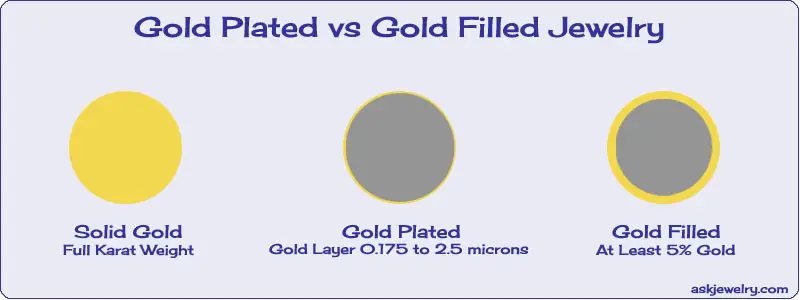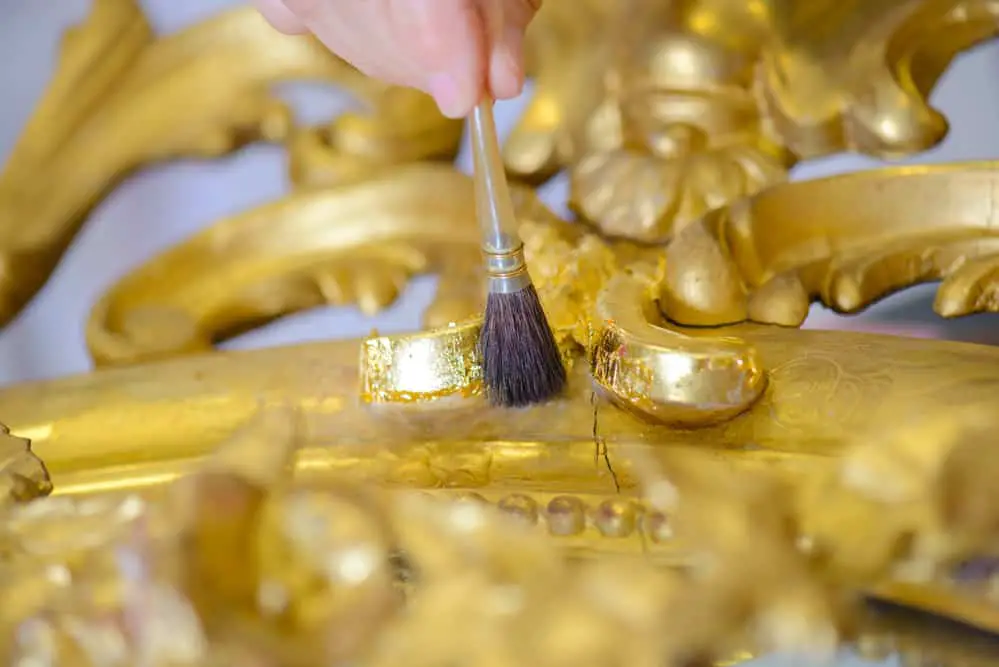Table of Contents
When it comes to jewelry, you don’t always get what you see. Techniques like plating, filling, and alloying are all used to reduce the amount of precious metals like gold in a given piece without losing that lustrous look. Of course, none of these are inherently wrong. Alloys can be used to create all kinds of interesting colors, while other techniques can bring the price of gold down to a more affordable range.
*This post may contain affiliate links. As an Amazon Associate we earn from qualifying purchases.
With that in mind, let’s take a look at what goes on in the jewelry industry and what the differences between plating, filling, and other techniques are.
Understanding Karats
The first thing to understand is the ‘karat’, or the percentage of precious metal contained in any given piece. Karats are measured in 24ths – so 24-karat gold is 100% gold (or rather, 99.9% gold – there are always a few trace impurities), while 12-karat gold is 50% gold.

Most gold jewelry in the United States is made with 14-karat gold, which is about 58.5% pure. The reason for this is simple: Pure gold is too soft to be used in jewelry. It’s too easy to bend and deform, so most jewelers prefer to alloy it with other metals (often copper or zinc) to improve a piece’s strength.
Products must be at least 10-karats (41.7% gold) to be sold as gold jewelry in the United States.
What Are Plated And Filled All About, Then?
There’s a big difference between plated metals vs. filled pieces.
What Does Gold Plated Mean?
Gold plating is a process where a thin layer of gold is applied to the base piece, which is usually brass. The actual amount of gold used is typically 0.05% of the piece’s weight, which is the main reason gold plated jewelry is affordable on any budget.
To get a better sense of what plating is like, imagine you have a stack of five hundred sheets of brown paper. On top of that, you place a single layer of opaque yellow paper. If all you want is the appearance of gold, it doesn’t matter what the insides are made of – as long as you have that top layer, you’re fine.

Unfortunately, gold plating is prone to rubbing off over time because it’s so thin. It does not stand up to heat, water, or contact with skin, making it a poor choice if you want to wear a piece of jewelry on a regular basis.
What Does Gold Filled Mean?
We don’t like this name very much, since ‘gold filled’ implies that gold is the filling. That’s not correct. Instead, gold filled pieces consist of a relatively thick outer layer of gold pressed and fused to the base piece.
By law, gold filled pieces must contain at least 5% gold. This ensures the outer layer is thick enough to hold up to frequent use – true filled pieces will not tarnish or rub off, and indeed, they should need no more than the occasional gentle cleaning to keep their shine.
The karat mark for gold filled jewelry refers only to the gold on the surface. For example, you may find a filled piece listed as “18-karat gold”, even though 95% of the piece is likely to be brass.
Are There Any Other Options For Covering Jewelry?
Yes! Gold filled vs. gold plated is the big competition, but there are a few other ways that jewelry can be covered in gold.
Gold Leaf
Gold leaf is an affordable, ultra-thin material that can be applied over other products and is usually coated with a protective layer to stop it from being scratched and torn away from the base. This is mostly used for artistic jewelry – for example, you can easily apply gold leaf over a little wood to create a distinctive natural texture.
The wide availability and low cost mean that gold leaf jewelry should be used only for appearances. It adds almost no value to any given piece.
Gold Overlay (Rolled Gold Plated)
Gold overlays – sometimes referred to as rolled gold plated, o R.G.P. instead – involve a thicker coating than gold plating but less than gold filled. In effect, this is a relatively uncommon medium between the two, but you may see a few pieces with this designation when you’re shopping.
Notably, gold overlay must have at least 10-karat gold on the outside, but it’s allowed to be less than 5% of the total weight. Personally, we prefer gold filled if you’re looking for a piece to wear on a regular basis. Gold overlay is a better choice for jewelry you don’t plan to wear too often or decorative pieces you don’t wear at all.
Vermeil

Vermeil is a special product, and distinct from all other gold layerings. Most of the techniques described above are about getting the cost of a piece down by filling the bulk of it with a cheap metal like brass. Vermeil, on the other hand, is exclusively used as gold plating over sterling silver (which is, itself, fairly valuable).
This is important since many of the other metals used for gold alloys can trigger metal allergies. Vermeil is generally safer to the touch. Unfortunately, this product is rarely marked as such – but if you see a gold-colored product market with “925” (or .925 or S925), it’s probably gold vermeil. 925 is the standard mark for Sterling Silver, representing the 92.5% purity, and it is almost never used for products primarily made out of gold.
What Karat Should The Outside Of A Piece Of Jewelry Be?
14-karat and 18-karat are considered ideal for the exterior of most jewelry pieces. When the gold is thick enough – as it is on gold filled pieces – that’s enough to provide an attractive color while still providing structural strength.
Having a strong core of brass does not change the fundamental problem of high-purity gold, which is that it’s too soft to use in jewelry. That said, the low amount of actual gold in plated and filled pieces means that you can get a high-karat exterior without having to dig too deeply into your bank account. Personally, we recommend 18-karat for the added resistance to tarnish.
What Type Of Gold Should I Use?
Yellow gold is the timeless classic – it has a pure color, it’s hypo-allergenic, and it doesn’t require much maintenance when the purity is high. However, it’s certainly not the only color you may find… and there are some other interesting types of gold available.
Note that some of these colors are rare outside of special orders, so you may have to talk to a jeweler if there’s a color or design you truly want.
White Gold

White gold is a term that refers to several different alloys. This type of gold usually contains up to 10% of another material.
Nickel is a strong, hard metal, making it ideal for rings and pins. Unfortunately, nickel allergies are also relatively common, making this a poor choice for many buyers.
Palladium creates white gold that’s soft and pliable, making it ideal for use with setting gemstones. Some goldsmiths add a few other metals for structure and strength – but either way, large pieces of palladium-based white gold are fairly rare.
Platinum-based white gold is used mostly for its attractive color – platinum is strong but expensive, essentially making it a higher-value (and safer) version of the nickel alloy.
Rose Gold

Rose Gold has an attractive reddish hue. It’s normally formed as an alloy of gold, silver, and copper. The latter pairs extremely well with gold, offering beauty and structure alike at an affordable price. The copper content of rose gold is mostly measured by the color of the metal – the more copper present, the brighter the red color.
Rose Gold typically has anywhere from 20% to 50% copper. Since silver can be used, checking the karat of the gold is not the best way to determine how much copper is included in a given piece. For example, 18-karat rose gold could have 2.75% silver or 5% silver, and the difference is enough to create a noticeable change in the overall hue of the metal.
In some cases, rose gold has up to 15% zinc included, which darkens the color.
Green Gold

Green gold, sometimes called electrum, is similar to rose gold. However, it has a higher percentage of silver, giving it a noticeably different hue. Ancient electrum pieces were often around 40% silver, but modern pieces have ranged from 20% to 80% each in gold and silver.
For this reason, it is strongly recommended that you only buy green gold pieces that come with a certificate of authenticity detailing the exact chemical composition. If you ever need to sell it – or get pieces that match the color – a detailed description of the piece will help.

